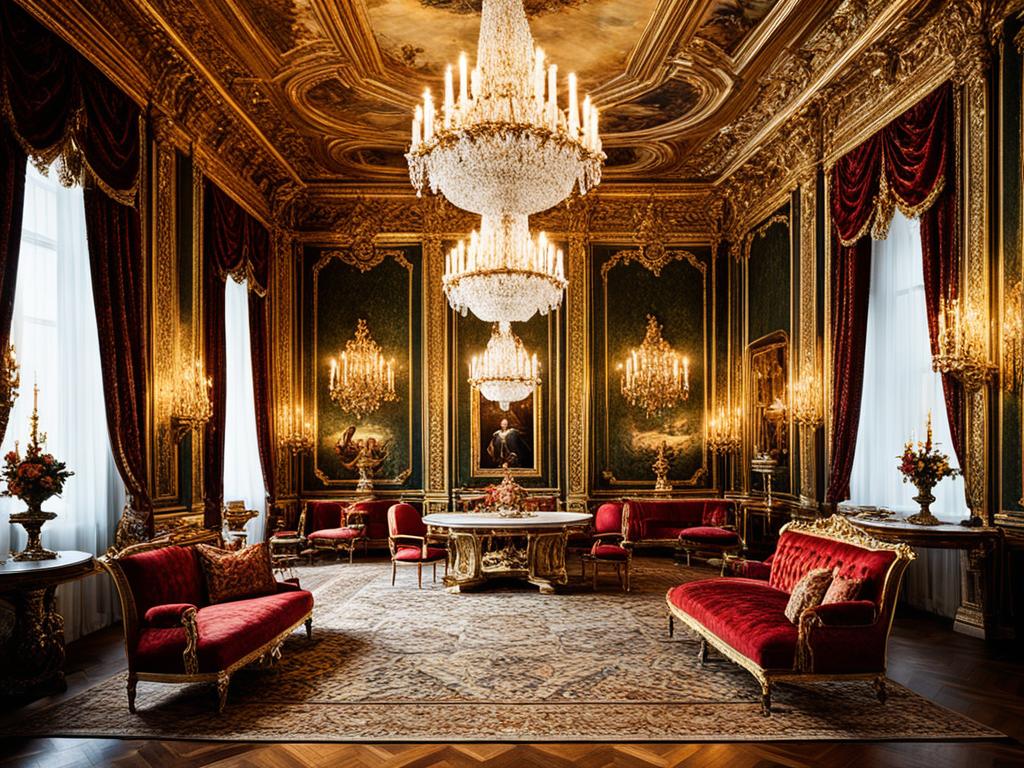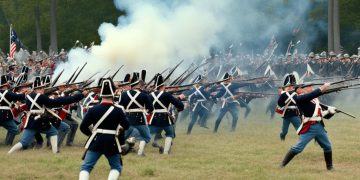Welcome to our exploration of the Habsburgs, a remarkable dynasty that left an indelible mark on European history. From their rise to power to their expansive empire and cultural patronage, the Habsburgs shaped the course of Europe through art, politics, and strategic maneuverings.
The Habsburgs’ story is one that spans centuries, with influential figures at the helm and vast territories under their rule. Join us on this journey as we uncover the fascinating history of the Habsburg dynasty and their enduring legacy.
Key Takeaways
- The Habsburgs were a prominent dynasty that greatly influenced European history through their art, politics, and expansive empire.
- Discover the rise of the Habsburg dynasty, as they forged alliances and expanded their power, becoming one of the most powerful families in Europe.
- Explore the notable individuals, from rulers to artists, who played significant roles in shaping Habsburg history and legacy.
- Learn about the Habsburg Empire’s expansion through territorial acquisitions, conquests, and strategic alliances.
- Delve into the rich artistic and cultural contributions made by the Habsburgs, leaving a lasting impact on European culture.
The Rise of the Habsburg Dynasty
The Habsburgs, one of the most influential dynasties in European history, had humble beginnings before ascending to power and prominence. Through strategic alliances and calculated expansions, they built an empire that spanned continents and shaped the course of history.
It all started in the Swiss town of Habsburg, where the dynasty originated in the late 10th century. In the early years, the Habsburgs were relatively modest in their holdings, ruling over a small territory. However, their ambitions grew with each generation.
Emperor Rudolf I, a key figure in Habsburg history, played a crucial role in solidifying their power. Through his strategic marriages and military conquests, he expanded the family’s influence across Central Europe. This laid the foundation for the rise of the Habsburg dynasty.
As their dominions grew, the Habsburgs formed strategic alliances with other powerful families and ruling houses. These alliances allowed them to strengthen their position and solidify their control over vast territories. The marriage of Maximilian I to Mary of Burgundy, for instance, brought the Netherlands and other regions under Habsburg rule.
With each generation, the Habsburg dynasty continued to expand its reach and accumulate wealth and power. By the 16th century, they had become one of the most formidable families in Europe, ruling over vast territories stretching from Spain to Austria and from Italy to the Netherlands.
Expanding Influence Through Inheritance and Marriage Alliances
The Habsburgs’ rise to power was also fueled by strategic marriages and inheritances. Through a series of advantageous unions, they gained control over valuable territories and inherited titles, further bolstering their status and influence.
Perhaps one of the most significant marriages in Habsburg history was the union of Ferdinand II and Isabella I, which united the kingdoms of Aragon and Castile and laid the groundwork for the creation of a global empire.
“I act as good as I can, hoping that such action will help unite the different parts of Europe; help the development of technology, arts, and culture; maintain peace for the prosperity of all.”
– Ferdinand II
The Habsburgs were skilled diplomatic negotiators, forging alliances with other powerful families through marriage. These alliances not only enhanced their political standing but also facilitated cultural exchange and economic cooperation.
Throughout their rise to power, the Habsburgs displayed a knack for diplomacy, military strategy, and opportunistic alliances. Their ability to navigate complex political landscapes paved the way for their ascent as one of the most influential families in European history.
The Early Years of Habsburg Rule
Once firmly established as a dominant force, the Habsburgs set out to consolidate their empire. They instituted effective governance systems, invested in infrastructure, and promoted cultural and intellectual development.
Under their reign, cities within Habsburg territories flourished, as trade and commerce thrived. They cultivated a sense of stability and prosperity that attracted merchants, artisans, and intellectuals from all corners of Europe.
Through their patronage of the arts, the Habsburgs fostered a vibrant cultural scene. They commissioned renowned artists such as Diego Velázquez and Hans Holbein the Younger, leaving behind a rich artistic legacy that continues to captivate audiences today.
| Key Factors | Impact |
|---|---|
| Marriage alliances | Expanded territorial control |
| Strategic military conquests | Increased political influence |
| Diplomatic negotiations | Strengthened alliances and cultural exchange |
The Habsburgs’ rise to power is an awe-inspiring tale of ambition, strategy, and perseverance. From their modest beginnings in Habsburg to their vast empire that spanned continents, their legacy continues to shape our understanding of European history.
Key Figures in Habsburg History
Explore the fascinating individuals who left an indelible mark on Habsburg history. From visionary rulers who shaped the destiny of nations to influential artists and thinkers who left a lasting cultural legacy, these key figures played pivotal roles in the illustrious Habsburg dynasty.
1. Emperor Charles V
Emperor Charles V, born in 1500, was a renowned ruler who presided over one of the most influential periods in Habsburg history. His empire spanned across Europe, encompassing territories in Spain, the Netherlands, parts of Italy, and the New World. Charles V’s reign witnessed iconic events such as the expansion of the Spanish Empire in the Americas and conflicts with the Ottoman Empire.
2. Empress Maria Theresa
Empress Maria Theresa, born in 1717, was the only female ruler of the Habsburg dominions. Recognized as one of the most formidable Habsburg monarchs, Maria Theresa implemented significant political and social reforms, modernizing administration, and promoting education. Her reign marked a period of stability and prosperity within the Habsburg Empire.
3. Archduke Ferdinand II
Archduke Ferdinand II, born in 1578, played a crucial role in shaping Habsburg history. As Holy Roman Emperor, he championed the Catholic Counter-Reformation during a time of religious conflict in Europe. His ambitions for Catholic supremacy fueled the devastating Thirty Years’ War, leaving a profound impact on the political and religious landscape of Central Europe.
4. Emperor Franz Joseph I
Emperor Franz Joseph I, born in 1830, reigned over the Habsburg Empire during a period of immense change and upheaval. His rule witnessed significant challenges, including the Austro-Hungarian Compromise of 1867, which transformed the empire into a dual monarchy. Franz Joseph I’s sixty-eight-year-long reign reflects the endurance and challenges of the Habsburg dynasty in a rapidly changing world.
| Key Figure | Life Span | Significance |
|---|---|---|
| Emperor Charles V | 1500-1558 | Ruled over a vast empire and shaped European politics. |
| Empress Maria Theresa | 1717-1780 | Implemented significant reforms and ensured the stability of the empire. |
| Archduke Ferdinand II | 1578-1637 | Championed the Catholic Counter-Reformation and instigated the Thirty Years’ War. |
| Emperor Franz Joseph I | 1830-1916 | Ruled during a time of great change and transformed the empire into a dual monarchy. |
These are just a few among the many remarkable individuals who shaped the legacy of the Habsburg dynasty. Their contributions as rulers, reformers, and patrons of the arts continue to reverberate through history, leaving an enduring impact on Europe and the world.
Continue the journey through Habsburg history to uncover the empire’s rapid expansion and the significant influence of art and culture under their patronage.
The Habsburg Empire’s Expansion
During its reign, the Habsburg Empire experienced significant territorial expansion, bolstering its power and influence across diverse regions. The strategic acquisitions, military conquests, and diplomatic alliances undertaken by the Habsburgs allowed them to establish a vast empire encompassing numerous territories and peoples.
One of the key factors contributing to the Habsburg Empire’s expansion was their ability to forge alliances with other European powers. Through marital unions and political agreements, the Habsburgs formed strategic partnerships that strengthened their position and facilitated territorial growth.
Furthermore, the Habsburg Empire diligently pursued military conquests, aiming to expand their dominion and establish control over new territories. Their campaigns, such as the Ottoman Wars, yielded significant victories and resulted in the acquisition of vast lands.
In addition to military and diplomatic endeavors, the Habsburgs also engaged in skilled diplomacy, negotiating alliances and treaties that secured their territorial gains and ensured stability within their empire.
The Habsburg Empire’s Expansions at a Glance
| Year | Acquisition/Conquest |
|---|---|
| 1477 | Integration of the Duchy of Burgundy into the Habsburg domains through the marriage of Mary of Burgundy to Archduke Maximilian I. |
| 1521 | Annexation of Spain and its territories through the marriage of King Ferdinand II of Aragon and Queen Isabella I of Castile. |
| 1526 | Acquisition of Bohemia and Hungary after the Battle of Mohács and coronation of Ferdinand I as King. |
| 1595 | Expansion into Transylvania, retaining control until 1699. |
Through a combination of military might, political acumen, and alliances, the Habsburg Empire’s expansion was marked by remarkable territorial gains and the establishment of a diverse and sprawling empire. This expansion would prove crucial in shaping the Habsburg dynasty’s influence and the course of European history.
Art and Culture Under the Habsburgs
The Habsburg dynasty’s influence extended beyond politics and power; they also played a significant role in shaping the artistic and cultural landscape of Europe. With their considerable wealth and patronage, the Habsburgs fostered a thriving environment for artistic expression and innovation.
Under the Habsburg rule, renowned artists were commissioned to create masterpieces that adorned palaces, churches, and public spaces across the empire. The dynasty’s support allowed artists to refine their craft and push the boundaries of artistic styles and techniques.
One notable example of the Habsburgs’ dedication to the arts was their patronage of the renowned painter, Diego Velázquez. Velázquez’s works, including his iconic portraits of members of the Spanish royal court, exemplify the elegance and sophistication favored by the Habsburgs. His art captured the essence of the era, showcasing the opulence and grandeur associated with the dynasty.
The Habsburgs’ patronage extended beyond painters. They also supported talented sculptors, architects, musicians, and writers, contributing to the vibrant cultural scene of the time.
The Habsburgs’ influence on artistic development was not limited to their patronage. They actively engaged with emerging artistic movements, supporting the development of new styles that reflected the changing artistic trends of the time.
The Vienna Secession: A Break from Tradition
One of the most significant artistic movements that emerged during the Habsburg era was the Vienna Secession. Spearheaded by artists such as Gustav Klimt, Egon Schiele, and Oskar Kokoschka, the Vienna Secession challenged traditional artistic conventions and embraced a more experimental approach.
The Vienna Secessionists sought to break free from academic norms and explore new forms of expression. Their art was characterized by symbolist and decorative elements, often blending imagination with reality.
The Habsburgs, recognizing the importance of fostering artistic innovation, supported the Vienna Secession movement. The dynasty’s patronage provided a platform for these artists to display their groundbreaking works and contribute to the cultural zeitgeist of the time.
| Key Artists Supported by the Habsburgs | Artistic Contributions |
|---|---|
| Gustav Klimt | Symbolist paintings, including “The Kiss” and “Portrait of Adele Bloch-Bauer I” |
| Jan van Eyck | Early Netherlandish painter known for his meticulous attention to detail |
| El Greco | Expressionist painter with a unique style, combining Byzantine influences with spiritual themes |
| Peter Paul Rubens | Baroque painter known for his grand historical and mythological compositions |
The lasting impact of the Habsburgs’ support for the arts is evident in the remarkable cultural heritage that still exists within the territories formerly ruled by the dynasty. Museums and galleries display countless works of art that reflect the Habsburgs’ influence and their dedication to preserving and promoting artistic excellence.
Conclusion
In conclusion, the fall of the Habsburg Dynasty marked a significant turning point in European history. The Fall of the Habsburg Dynasty was the result of various factors, including internal conflicts, external pressures, and the changing geopolitical landscape. These circumstances ultimately led to the downfall of one of Europe’s most powerful and long-standing ruling families.
The Habsburgs’ impact on European politics cannot be overstated. Throughout their reign, they played a pivotal role in shaping the continent’s political landscape and exerting their influence on a global scale. Their empire’s vast territory The Habsburgs’ Impact on European Politics encompassed diverse regions and peoples, allowing them to exert control and shape the course of history.
Although the Habsburg Dynasty may have fallen, their legacy The Fall of the Habsburg Dynasty, The Habsburgs’ Impact on European Politics continues to reverberate in Europe and beyond. The repercussions of their rule can still be seen in the political structures, cultural developments, and historical events that unfolded in the aftermath of their decline. Their impact on European politics and history remains a subject of study and fascination, as their dynasty left an indelible mark on the course of European civilization.







